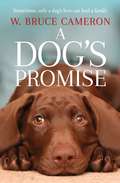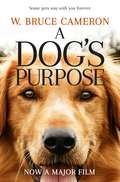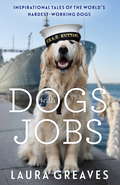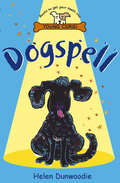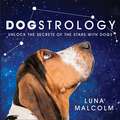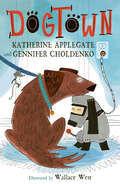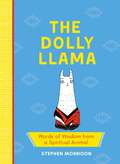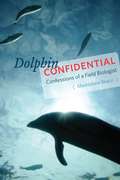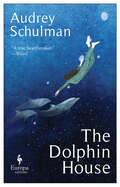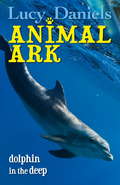- Table View
- List View
Dogs on wheels: Travelling with your canine companion (RAC Handbook)
by Norm MortDogs on Wheels - travelling with your canine companion takes a look at you, your family, your vehicle, and most importantly your dog, and tells you how to get the most out of travelling with your four-legged friend - whether for five minutes or five hours. Helpful advice, insights into your dog's world, and guidance on choosing the right vehicle are only a part of this comprehensive look at travelling with your dog. Packed with original colour photographs, and containing invaluable information and opinion from veterinarians and an animal behaviourist.
A Dog's Perfect Christmas
by W. Bruce CameronThe perfect, feel-good holiday gift from W. Bruce Cameron, the #1 New York Times bestselling author of the A Dog’s Purpose series.The problems fracturing the Goss family as Christmas approaches are hardly unique, though perhaps they are handling them a little differently than most people might. But then a true emergency arises, one with the potential to not only ruin Christmas, but everything holding the family together.Is the arrival of a lost puppy yet another in the string of calamities facing them, or could the little canine be just what they all need?A Dog’s Perfect Christmas is a beautiful, poignant, delightful tale of what can happen when family members open their hearts to new possibilities. You’ll find love and tears and laughter, the ideal holiday read.
A Dog's Promise (A Dog's Purpose #3)
by W. Bruce CameronSometimes, only a dog's love can heal a family. A Dog’s Promise is the heart-warming and uplifting story about a dog who helps a family that are on the verge of breaking apart. From W. Bruce Cameron the international number one bestselling author of A Dog's Purpose, this novel is perfect of fans of Garth Stein's Art of Racing in the Rain. Bailey knows one thing for sure: all dogs who offer unconditional love, just like him, are destined for heaven.But before Bailey can rest in peace, there’s one family in particular that needs his help. A family that is on the verge of breaking apart. Bailey knows that helping this family means he won’t remember his previous lives, and the other families that he’s met and loved, but sometimes making the sacrifice to help those in need is its own reward. Deeply emotional and beautifully told, A Dog’s Promise will speak to dog lovers all over the world who know that their pets are sent to them for a reason and that their love can heal all wounds.
A Dog's Purpose: A novel for humans (A Dog's Purpose #1)
by W. Bruce CameronThe phenomenal New York Times Number One bestseller about the unbreakable bond between a dog and their human. Now a major film starring Dennis Quaid.This is the remarkable story of one endearing dog's search for his purpose over the course of several lives. More than just another charming dog story, A Dog's Purpose touches on the universal quest for an answer to life's most basic question: Why are we here?Surprised to find himself reborn as a rambunctious golden-haired puppy after a tragically short life as a stray mutt, Bailey's search for his new life's meaning leads him into the loving arms of eight-year-old Ethan. During their countless adventures, Bailey joyously discovers how to be a good dog.But this life as a family pet is not the end of Bailey's journey. Reborn as a puppy yet again, Bailey wonders – will he ever find his purpose?Heartwarming, insightful, and often laugh-out-loud funny, W. Bruce Cameron's A Dog's Purpose is not only the emotional and hilarious story of a dog's many lives, but also a dog's-eye commentary on human relationships and the unbreakable bonds between man and man's best friend. This moving and beautifully crafted story teaches us that love never dies, and that every creature on earth is born with a purpose.
A Dog's Way Home: The Heartwarming Story of the Special Bond Between Man and Dog (A Dog's Way Home #1)
by W. Bruce CameronNOW A MAJOR FILM STARRING ASHLEY JUDDFrom W. Bruce Cameron, the author of A Dog’s Purpose, the number one New York Times bestseller and major film comes a completely unforgettable adventure as one devoted dog makes her way home.When Lucas Ray rescued his puppy Bella he knew his life would change forever.Smuggling her into his building isn't easy, particularly with his prying neighbours, and Lucas decides to risk taking her to work. The joy on the faces of the veterans in his hospital as Bella distributes her unique brand of comfort makes it all worth it.But then Bella is picked up by animal control and Lucas makes the heartbreaking decision to send her away. Lucas hasn't understood Bella's feelings, though. There might be hundreds of miles separating them but Bella wants her master and she is coming to find him . . .A Dog's Way Home is a heartwarming story perfect for fans of Marley & Me, A Street Cat Named Bob and The Art of Racing in the Rain.
Dogs Who Changed the World: 50 dogs who altered history, inspired literature... or ruined everything
by Dan JonesDogs Who Changed the World is a beautifully illustrated, heart-warming book that celebrates all dogs and proves that every single one of them is absolute magic. Dogs have trotted at our collective side for tens of thousands of years, bound up in the story of humanity. They have inspired great works of art, caught spies, reconnected lost lovers, dragged the drowning to safety... or have just haplessly and happily ruined everything.These 50 tales acknowledge our unbreakable relationship with the dog, the ?rst-ever domesticated animal, and their dedication, heroism and unending sense of fun. Along the way we'll meet big-boned Barry, the hefty St Bernard credited with saving the lives of more than 40 lost souls in the Swiss Alps in the 1800s. We'll discover Sigmund Freud's calm-inducing chow chow, Jo?, who would sit in on his psychotherapy sessions (and never spilled a secret), and feel the frustration of Sir Isaac Newton, whose little terror Diamond apparently knocked over a candle and destroyed the physicist's most important manuscripts.
Dogs With Jobs: Inspirational Tales of the World’s Hardest-Working Dogs
by Laura GreavesMeet Molly Polly, the diabetes alert dog whose round-the-clock job is to keep her two young owners healthy; Bailey, the Assistant Director of Seagulls, who keeps the pesky birds away from the heritage vessels at the Australian National Maritime Museum; and Daisy, the Collie mix who's a full-time guide dog for another dog. From inspirational moments of bravery to dogs doing the jobs that no one else can, these are the life-affirming stories of the most remarkable dogs on the planet.
A Dog's World: Imagining the Lives of Dogs in a World without Humans
by Marc Bekoff Jessica PierceFrom two of the world’s leading authorities on dogs, an imaginative journey into a future of dogs without peopleWhat would happen to dogs if humans simply disappeared? Would dogs be able to survive on their own without us? A Dog’s World imagines a posthuman future for dogs, revealing how dogs would survive—and possibly even thrive—and explaining how this new and revolutionary perspective can guide how we interact with dogs now.Drawing on biology, ecology, and the latest findings on the lives and behavior of dogs and their wild relatives, Jessica Pierce and Marc Bekoff—two of today’s most innovative thinkers about dogs—explore who dogs might become without direct human intervention into breeding, arranged playdates at the dog park, regular feedings, and veterinary care. Pierce and Bekoff show how dogs are quick learners who are highly adaptable and opportunistic, and they offer compelling evidence that dogs already do survive on their own—and could do so in a world without us.Challenging the notion that dogs would be helpless without their human counterparts, A Dog’s World enables us to understand these independent and remarkably intelligent animals on their own terms.
Dogspell
by Helen DunwoodieDaisy and Robina are desperate for a dog. They've tried everything and in desperation they sneak a book about magic out of their older sister's room and try to cast a spell. Later that day, to their great amazement and delight, a dog appears in their house. The curious-looking mutt resembles a cross between a poodle and an afghan hound and the girls love their 'afoodle' on sight. Dad, however, has a more prosaic explanation for the dog's appearance, and what it's doing in their house. But all the girls want to know is, can he stay?
Dogstrology: Unlock the Secrets of the Stars with Dogs
by Luna MalcolmWith the help of a collection of sweet and hilarious dog pictures, DOGSTROLOGY will unlock all the secrets of the stars that you need to know, including...- Each of the signs at their best and worst (and the perfect pup to illustrate them)- The common traits of each element and modality in the zodiac- What do you and your 'sister sign' have in common? Find out, with the perfect dog photo to complement it...- And of course: the right dog for you, based on your star sign!
Dogtown
by Katherine Applegate Gennifer CholdenkoFrom beloved authors Katherine Applegate and Gennifer Choldenko, Dogtown is an uplifting story and a page-turning adventure.Dogtown is a shelter for stray dogs, misbehaving dogs, and discarded robot dogs, whose owners have outgrown them.Chance, a real dog, has been in Dogtown since his owners unwittingly left him with irresponsible dog-sitters who skipped town.Metal Head is a robot dog who dreams of being back in a real home.And Mouse is a mouse who has the run of Dogtown, pilfering kibble, and performing clever feats to protect the dogs he loves.When Chance and Metal Head embark on an adventure to find their forever homes, there is danger, cheese sandwiches, a charging station, and some unexpected kindnesses along the way.
Doing Bird
by Martin GurdonMeet the Flockers -a soap opera of love, life and eggsAfter fourteen years of garden chicken keeping Martin Gurdon thought adding some ducks and doves to his flock would be harmless fun. He didn't realise what he was letting himself in for. Garden chicken and bird keeping has never been more popular, there are plenty of practical books that show you how, but this one reveals the often-bizarre, sometimes moving but always hilarious reality.Charting the seasonal highs and lows in a year of an amateur domestic bird owner and his flock, Doing Bird introduces you to world filled with ducks who think they're chickens, a hen called Ann Summers, invading foxes, rabbits and builders, vast vet bills, doves needing parenting classes and Bombay, the drake with an unrequited love for Bella the chicken.This is a fowl story of a man, a woman and a load of feathery trouble.
The Dolly Llama: Words of Wisdom from a Spiritual Animal
by Stephen Morrison‘Ridiculous and funny’ – GREG DAVIES‘In a fast-moving world, the only self-help book I recommend is this collection of the words from the Dolly Llama’ – ED GAMBLELlama Karma lies within you.The Dolly Llama, the world’s first behooved spiritual leader, shares his words of wisdom and spiritual teachings for the first time. In this gem of a book he shows you how cultivate Llama Karma and to bring peace, compassion and ‘cuditation’ (a form of chewing and meditation) into your everyday life.His Gentleness has drawn great inspiration from ‘the four bales of wisdom’ which have helped many grazer browsers before him on the rocky path of life. Take a leaf out of this book and learn how Llama Karma can help you harness inner calm, as well as cope with everyday problems like hoof infection. The perfect gift for llama-lovers, spiritualists and animal-lovers alike.
Dolphin Confidential: Confessions of a Field Biologist
by Maddalena BearziWho hasn’t fantasized about the unique thrill of working among charismatic and clever dolphins in the wild? Now we no longer have to rely solely on our imaginations . With Dolphin Confidential, Maddalena Bearzi invites all of us shore-bound dreamers to join her and travel alongside the dolphins. In this fascinating account, she takes us inside the world of a marine scientist and offers a firsthand understanding of marine mammal behavior, as well as the frustrations, delights, and creativity that make up dolphin research. In this intimate narrative, Bearzi recounts her experiences at sea, tracing her own evolution as a woman and a scientist from her earliest travails to her transformation into an advocate for conservation and dolphin protection. These compelling, in-depth descriptions of her fieldwork also present a captivating look into dolphin social behavior and intelligence. The central part of the book is devoted to the metropolitan bottlenose dolphins of California, as Bearzi draws on her extensive experience to offer insights into the daily lives of these creatures—as well as the difficulties involved in collecting the data that transforms hunches into hypotheses and eventually scientific facts. The book closes by addressing the critical environmental and conservation problems facing these magnificent, socially complex, highly intelligent, and emotional beings. An honest, down-to-earth analysis of what it means to be a marine biologist in the field today, Dolphin Confidential offers an entertaining, refreshingly candid, and always informative description of life among the dolphins.
Dolphin Confidential: Confessions of a Field Biologist
by Maddalena BearziWho hasn’t fantasized about the unique thrill of working among charismatic and clever dolphins in the wild? Now we no longer have to rely solely on our imaginations . With Dolphin Confidential, Maddalena Bearzi invites all of us shore-bound dreamers to join her and travel alongside the dolphins. In this fascinating account, she takes us inside the world of a marine scientist and offers a firsthand understanding of marine mammal behavior, as well as the frustrations, delights, and creativity that make up dolphin research. In this intimate narrative, Bearzi recounts her experiences at sea, tracing her own evolution as a woman and a scientist from her earliest travails to her transformation into an advocate for conservation and dolphin protection. These compelling, in-depth descriptions of her fieldwork also present a captivating look into dolphin social behavior and intelligence. The central part of the book is devoted to the metropolitan bottlenose dolphins of California, as Bearzi draws on her extensive experience to offer insights into the daily lives of these creatures—as well as the difficulties involved in collecting the data that transforms hunches into hypotheses and eventually scientific facts. The book closes by addressing the critical environmental and conservation problems facing these magnificent, socially complex, highly intelligent, and emotional beings. An honest, down-to-earth analysis of what it means to be a marine biologist in the field today, Dolphin Confidential offers an entertaining, refreshingly candid, and always informative description of life among the dolphins.
Dolphin Confidential: Confessions of a Field Biologist
by Maddalena BearziWho hasn’t fantasized about the unique thrill of working among charismatic and clever dolphins in the wild? Now we no longer have to rely solely on our imaginations . With Dolphin Confidential, Maddalena Bearzi invites all of us shore-bound dreamers to join her and travel alongside the dolphins. In this fascinating account, she takes us inside the world of a marine scientist and offers a firsthand understanding of marine mammal behavior, as well as the frustrations, delights, and creativity that make up dolphin research. In this intimate narrative, Bearzi recounts her experiences at sea, tracing her own evolution as a woman and a scientist from her earliest travails to her transformation into an advocate for conservation and dolphin protection. These compelling, in-depth descriptions of her fieldwork also present a captivating look into dolphin social behavior and intelligence. The central part of the book is devoted to the metropolitan bottlenose dolphins of California, as Bearzi draws on her extensive experience to offer insights into the daily lives of these creatures—as well as the difficulties involved in collecting the data that transforms hunches into hypotheses and eventually scientific facts. The book closes by addressing the critical environmental and conservation problems facing these magnificent, socially complex, highly intelligent, and emotional beings. An honest, down-to-earth analysis of what it means to be a marine biologist in the field today, Dolphin Confidential offers an entertaining, refreshingly candid, and always informative description of life among the dolphins.
Dolphin Confidential: Confessions of a Field Biologist
by Maddalena BearziWho hasn’t fantasized about the unique thrill of working among charismatic and clever dolphins in the wild? Now we no longer have to rely solely on our imaginations . With Dolphin Confidential, Maddalena Bearzi invites all of us shore-bound dreamers to join her and travel alongside the dolphins. In this fascinating account, she takes us inside the world of a marine scientist and offers a firsthand understanding of marine mammal behavior, as well as the frustrations, delights, and creativity that make up dolphin research. In this intimate narrative, Bearzi recounts her experiences at sea, tracing her own evolution as a woman and a scientist from her earliest travails to her transformation into an advocate for conservation and dolphin protection. These compelling, in-depth descriptions of her fieldwork also present a captivating look into dolphin social behavior and intelligence. The central part of the book is devoted to the metropolitan bottlenose dolphins of California, as Bearzi draws on her extensive experience to offer insights into the daily lives of these creatures—as well as the difficulties involved in collecting the data that transforms hunches into hypotheses and eventually scientific facts. The book closes by addressing the critical environmental and conservation problems facing these magnificent, socially complex, highly intelligent, and emotional beings. An honest, down-to-earth analysis of what it means to be a marine biologist in the field today, Dolphin Confidential offers an entertaining, refreshingly candid, and always informative description of life among the dolphins.
Dolphin Confidential: Confessions of a Field Biologist
by Maddalena BearziWho hasn’t fantasized about the unique thrill of working among charismatic and clever dolphins in the wild? Now we no longer have to rely solely on our imaginations . With Dolphin Confidential, Maddalena Bearzi invites all of us shore-bound dreamers to join her and travel alongside the dolphins. In this fascinating account, she takes us inside the world of a marine scientist and offers a firsthand understanding of marine mammal behavior, as well as the frustrations, delights, and creativity that make up dolphin research. In this intimate narrative, Bearzi recounts her experiences at sea, tracing her own evolution as a woman and a scientist from her earliest travails to her transformation into an advocate for conservation and dolphin protection. These compelling, in-depth descriptions of her fieldwork also present a captivating look into dolphin social behavior and intelligence. The central part of the book is devoted to the metropolitan bottlenose dolphins of California, as Bearzi draws on her extensive experience to offer insights into the daily lives of these creatures—as well as the difficulties involved in collecting the data that transforms hunches into hypotheses and eventually scientific facts. The book closes by addressing the critical environmental and conservation problems facing these magnificent, socially complex, highly intelligent, and emotional beings. An honest, down-to-earth analysis of what it means to be a marine biologist in the field today, Dolphin Confidential offers an entertaining, refreshingly candid, and always informative description of life among the dolphins.
Dolphin Confidential: Confessions of a Field Biologist
by Maddalena BearziWho hasn’t fantasized about the unique thrill of working among charismatic and clever dolphins in the wild? Now we no longer have to rely solely on our imaginations . With Dolphin Confidential, Maddalena Bearzi invites all of us shore-bound dreamers to join her and travel alongside the dolphins. In this fascinating account, she takes us inside the world of a marine scientist and offers a firsthand understanding of marine mammal behavior, as well as the frustrations, delights, and creativity that make up dolphin research. In this intimate narrative, Bearzi recounts her experiences at sea, tracing her own evolution as a woman and a scientist from her earliest travails to her transformation into an advocate for conservation and dolphin protection. These compelling, in-depth descriptions of her fieldwork also present a captivating look into dolphin social behavior and intelligence. The central part of the book is devoted to the metropolitan bottlenose dolphins of California, as Bearzi draws on her extensive experience to offer insights into the daily lives of these creatures—as well as the difficulties involved in collecting the data that transforms hunches into hypotheses and eventually scientific facts. The book closes by addressing the critical environmental and conservation problems facing these magnificent, socially complex, highly intelligent, and emotional beings. An honest, down-to-earth analysis of what it means to be a marine biologist in the field today, Dolphin Confidential offers an entertaining, refreshingly candid, and always informative description of life among the dolphins.
Dolphin Confidential: Confessions of a Field Biologist
by Maddalena BearziWho hasn’t fantasized about the unique thrill of working among charismatic and clever dolphins in the wild? Now we no longer have to rely solely on our imaginations . With Dolphin Confidential, Maddalena Bearzi invites all of us shore-bound dreamers to join her and travel alongside the dolphins. In this fascinating account, she takes us inside the world of a marine scientist and offers a firsthand understanding of marine mammal behavior, as well as the frustrations, delights, and creativity that make up dolphin research. In this intimate narrative, Bearzi recounts her experiences at sea, tracing her own evolution as a woman and a scientist from her earliest travails to her transformation into an advocate for conservation and dolphin protection. These compelling, in-depth descriptions of her fieldwork also present a captivating look into dolphin social behavior and intelligence. The central part of the book is devoted to the metropolitan bottlenose dolphins of California, as Bearzi draws on her extensive experience to offer insights into the daily lives of these creatures—as well as the difficulties involved in collecting the data that transforms hunches into hypotheses and eventually scientific facts. The book closes by addressing the critical environmental and conservation problems facing these magnificent, socially complex, highly intelligent, and emotional beings. An honest, down-to-earth analysis of what it means to be a marine biologist in the field today, Dolphin Confidential offers an entertaining, refreshingly candid, and always informative description of life among the dolphins.
The Dolphin House: A moving novel on connection and community
by Audrey Schulman“Schulman delivers the known world in startling new sounds, colours, tastes and smells.”—New York Times Sunday Book Review It is 1965 and Cora, a deaf young woman, buys a one-way ticket to the island of St Thomas, where she discovers four dolphins held in captivity, part of an experiment led by an obsessive Dr Bloom. Drawn by a strong connection to the dolphins, untrained Cora falls in with the scientists to protect the animals. Recognising Cora's knack for communication, Bloom uses her for what will turn into one of the most fascinating experiments in modern science: an attempt to teach the dolphins human language. As the experiment progresses, Cora forges a remarkable bond with the creatures that leads to a clash with the male-dominated world of science, threatening to engulf the experiment as Cora’s fight to save the dolphins becomes a battle to save herself. For fans of Lessons in Chemistry by Bonnie Garmus.
Dolphin in the Deep: Dolphin In The Deep Ebook (Animal Ark #No. 31)
by Lucy DanielsAnimal Ark is the veterinary surgery run by Mandy Hope's parents. If there are animals to be protected or looked after, Mandy is always there to help.A trip to the States is a dream come true for Mandy! She loves playing with two tame dolphins, Bob and Bing. But when Bob dies, the lonely Bing pines for company. But will Mandy's daring plan to cheer him up work?DOLPHIN IN THE DEEP is one of the best-loved ANIMAL ARK stories. Have you read them all?
Dolphin (large print)
by RnibThis image shows a dolphin seen from the side with its head on the left of the page and its tail on the right of the page. There is a locator dot shown, which will be at the top left of the page when the image is the correct way up. The dolphin has a beak-like mouth that sticks out to the left. The mouth is closed and appears to have a subtle smile, but this is an artifice. To the right of the mouth is one of its two eyes. At the bottom of the image is one of its two pectoral flippers. In the top centre of the dolphin is a dorsal fin. On the right of the page the tail is turned so both the right and left tail flipper can be found. The dolphin is a blue-grey and its belly is paler than its back.
Dolphin (UEB contracted)
by RnibThis image shows a dolphin seen from the side with its head on the left of the page and its tail on the right of the page. There is a locator dot shown, which will be at the top left of the page when the image is the correct way up. The dolphin has a beak-like mouth that sticks out to the left. The mouth is closed and appears to have a subtle smile, but this is an artifice. To the right of the mouth is one of its two eyes. At the bottom of the image is one of its two pectoral flippers. In the top centre of the dolphin is a dorsal fin. On the right of the page the tail is turned so both the right and left tail flipper can be found. The dolphin is a blue-grey and its belly is paler than its back.
Dolphin (UEB uncontracted)
by RnibThis image shows a dolphin seen from the side with its head on the left of the page and its tail on the right of the page. There is a locator dot shown, which will be at the top left of the page when the image is the correct way up. The dolphin has a beak-like mouth that sticks out to the left. The mouth is closed and appears to have a subtle smile, but this is an artifice. To the right of the mouth is one of its two eyes. At the bottom of the image is one of its two pectoral flippers. In the top centre of the dolphin is a dorsal fin. On the right of the page the tail is turned so both the right and left tail flipper can be found. The dolphin is a blue-grey and its belly is paler than its back.


